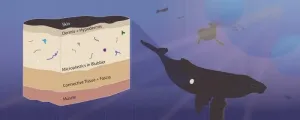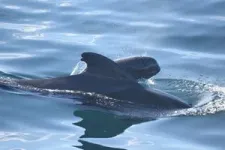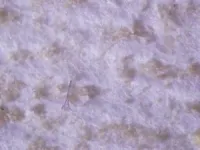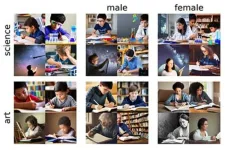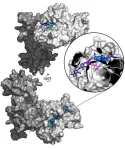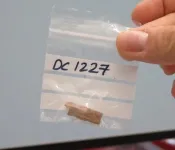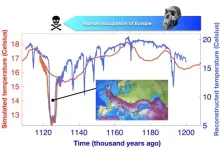(Press-News.org) BEAUFORT, N.C. – Microscopic plastic particles have been found in the fats and lungs of two-thirds of the marine mammals in a graduate student’s study of ocean microplastics. The presence of polymer particles and fibers in these animals suggests that microplastics can travel out of the digestive tract and lodge in the tissues.
The study, slated for the Oct. 15 edition of Environmental Pollution, appeared online this week.
Harms that embedded microplastics might cause to marine mammals are yet to be determined, but plastics have been implicated by other studies as possible hormone mimics and endocrine disruptors.
“This is an extra burden on top of everything else they face: climate change, pollution, noise, and now they're not only ingesting plastic and contending with the big pieces in their stomachs, they're also being internalized,” said Greg Merrill Jr., a fifth-year graduate student at the Duke University Marine Lab. “Some proportion of their mass is now plastic.”
The samples in this study were acquired from 32 stranded or subsistence-harvested animals between 2000 and 2021 in Alaska, California and North Carolina. Twelve species are represented in the data, including one bearded seal, which also had plastic in its tissues.
Plastics are attracted to fats – they’re lipophilic – and so believed to be easily attracted to blubber, the sound-producing melon on a toothed whale’s forehead, and the fat pads along the lower jaw that focus sound to the whales’ internal ears. The study sampled those three kinds of fats plus the lungs and found plastics in all four tissues.
Plastic particles identified in tissues ranged on average from 198 microns to 537 microns – a human hair is about 100 microns in diameter. Merrill points out that, in addition to whatever chemical threat the plastics pose, plastic pieces also can tear and abrade tissues.
“Now that we know plastic is in these tissues, we’re looking at what the metabolic impact might be,” Merrill said. For the next stage of his dissertation research, Merrill will use cell lines grown from biopsied whale tissue to run toxicology tests of plastic particles.
Polyester fibers, a common byproduct of laundry machines, were the most common in tissue samples, as was polyethylene, which is a component of beverage containers. Blue plastic was the most common color found in all four kinds of tissue.
A 2022 paper in Nature Communications estimated, based on known concentrations of microplastics off the Pacific Coast of California, that a filter-feeding blue whale might be gulping down 95 pounds of plastic waste per day as it catches tiny creatures in the water column. Whales and dolphins that prey on fish and other larger organisms also might be acquiring accumulated plastic in the animals they eat, Merrill said.
“We haven’t done the math, but most of the microplastics probably do pass through the gut and get defecated. But some proportion of it is ending up in the animals’ tissues,” Merrill said.
“For me, this just underscores the ubiquity of ocean plastics and the scale of this problem,” Merrill said. “Some of these samples date back to 2001. Like, this has been happening for at least 20 years.”
This work was supported by the National Science Foundation, the North Carolina Wildlife Federation and North Carolina Sea Grant (2018-2791-17).
CITATION: “Microplastics in Marine Mammal Blubber, Melon, & Other Tissues: Evidence of Translocation,” Greg Merrill, Ludovic Hermabessiere, Chelsea Rochman, Douglas Nowacek. Environmental Pollution, Oct. 15, 2023. DOI: 10.1016/j.envpol.2023.122252
Online (open access) - https://www.sciencedirect.com/science/article/pii/S026974912301254X
END
Microplastics found embedded in tissues of whales and dolphins
Analysis indicates ingested microplastics migrate into whales’ fat and organs
2023-08-10
ELSE PRESS RELEASES FROM THIS DATE:
Tool finds bias in state-of-the-art generative AI model
2023-08-10
Text-to-image (T2I) generative artificial intelligence tools are increasingly powerful and widespread tools that can create nearly any image based on just a few inputted words. T2I generative AI can create convincingly realistic photos and videos which are being used more and more for a multitude of purposes, from art to political campaigning.
However, the algorithmic models that power these tools are trained on data from humans, and can replicate human biases in the images they produce, such as biases around gender and skin tone. These biases can harm marginalized populations, reinforcing stereotypes and potentially leading to discrimination.
To address these implicit biases, ...
Chloride Ions From Seawater Eyed As Possible Lithium Replacement In Batteries of the Future
2023-08-10
Sodium, Potassium and zinc have all been promising contenders for lithium’s place in rechargeable batteries of the future, but researchers at Worcester Polytechnic Institute (WPI) have added an unusual and more abundant competitor to the mix: chloride, the richest negatively charged ions in seawater.
Xiaowei Teng, the James H. Manning professor of Chemical Engineering at WPI, has discovered a new redox chemistry empowered by chloride ions for the development of seawater green batteries.
Modern lithium-ion batteries used in various applications, including electric vehicles, can be problematic for grid storage, given their ...
Mechanism underlying bacterial resistance to the antibiotic albicidin revealed
2023-08-10
A new analysis shows that infectious bacteria exposed to the antibiotic albicidin rapidly develop up to a 1,000-fold increase in resistance via a gene amplification mechanism. Mareike Saathoff of Freie Universität Berlin, Germany, and colleagues present these findings August 10th in the open access journal PLOS Biology.
Bacterial resistance to antibiotics is a growing problem associated with millions of deaths around the world every year. Understanding how bacteria evolve resistance is key to developing more effective antibiotics and strategies for using them.
In recent years, albicidin has emerged as a promising antibiotic capable of killing a wide range of bacterial species ...
Researchers engineer bacteria that can detect tumor DNA
2023-08-10
Pushing into a new chapter of technologically advanced biological sensors, scientists from the University of California San Diego and their colleagues in Australia have engineered bacteria that can detect the presence of tumor DNA in a live organism.
Their innovation, which detected cancer in the colons of mice, could pave the way to new biosensors capable of identifying various infections, cancers and other diseases.
The advancement is described Aug. 11, 2023, in the journal Science. Bacteria previously have been designed to carry out various diagnostic and therapeutic functions, but lacked the ability to identify specific DNA sequences and mutations outside ...
Climate modeling reveals new insights into hominin migration and evolution
2023-08-10
In two studies, researchers demonstrate how climate modeling approaches can fill gaps in our understanding of hominin evolution and migration.
Over the last several decades, research efforts into the lives of hominins – humans and their close ancestors – have shifted from identifying fossils and artifacts to understanding the environmental and climate settings in which they lived and how these factors could have influenced hominin evolution and migration. However, like the hominin fossil record, environmental and climate records that accurately capture environmental change and span the period over which ...
New approaches enable chemical upcycling of polyethylene and polypropylene plastics
2023-08-10
In two studies, researchers present new ways to convert common waste plastics, polyethylene (PE) and polypropylene (PP), into high-value chemical products, including alcohols, aldehydes, surfactants, and detergents. The approaches provide a pathway toward creating a circular plastics economy and the ability to produce high-value chemicals more sustainably. Waste plastics are increasingly being considered a potentially abundant source of feedstock to produce valuable chemical compounds. However, some plastics, particularly polyolefin plastics like PE and PP – widely used commodity plastics that account ...
Special Issue: Australia
2023-08-10
In this Special Issue of Science, three Reviews, a Policy Forum, and a Perspective highlight Australia’s exceptional exposure to the risks of climate change and ecosystem degradation. Australia is home to Earth’s most ancient ecosystems and oldest continuous indigenous cultures, which have survived for more than 60,000 years. However, the continent’s unique ecosystems and cultural history have proved vulnerable to waves of European colonization and its associated social and environmental impacts. Ongoing climate change and the ...
Global ecosystem water use efficiency has stalled since 2001
2023-08-10
Increases in global ecosystem water use efficiency – the ratio between carbon assimilation to water evapotranspiration – have stalled since 2001 due to a rising vapor pressure deficit, according to a new study. The findings highlight one way that the adverse effects of our warming climate may undermine human reliance on nature-based climate solutions to achieve carbon neutrality. The rapid rise of atmospheric carbon dioxide (CO2) has led to substantial changes in global terrestrial carbon and water cycles. One of these impacts has been a generalized increase in ecosystem water use efficiency (WUEeco). On a global scale, WUEeco plays ...
A climate-orchestrated early human love story
2023-08-10
A new study published in the journal Science by an international team finds that past changes in atmospheric CO2 and corresponding shifts in climate and vegetation played a key role in determining when and where early human species interbred.
Modern-day people carry in their cells a small quantity of DNA deriving from other human species, namely the Neanderthals and the elusive Denisovans. Back in 2018, scientists announced to the world the discovery of an individual [Figure 1], later nicknamed Denny, who lived 90,000 years ago and who was identified as a daughter to a Denisovan father and a Neanderthal mother [Slon et al. 2018]. Denny, along with fellow mixed-ancestry ...
How a massive North Atlantic cooling event disrupted early human occupation in Europe
2023-08-10
A new study published in the journal Science finds that around 1.12 million years ago a massive cooling event in the North Atlantic and corresponding shifts in climate, vegetation and food resources disrupted early human occupation of Europe.
The study published by an international group of scientists from the UK, South Korea and Spain presents observational and modelling evidence documenting that unprecedented climate stress changed the course of early human history.
Archaic humans, known as Homo erectus moved from Africa into central Eurasia around 1.8 million years. From there on they spread towards western Europe, reaching the Iberian peninsula around 1.5 million ...
LAST 30 PRESS RELEASES:
Scientists trace microplastics in fertilizer from fields to the beach
The Lancet Obstetrics, Gynecology, & Women’s Health: Taking paracetamol during pregnancy does not increase risk of autism, ADHD or intellectual disabilities, confirms new gold-standard evidence review
Taking paracetamol during pregnancy does not increase risk of autism, ADHD or intellectual disabilities
Harm reduction vending machines in New York State expand access to overdose treatment and drug test strips, UB studies confirm
University of Phoenix releases white paper on Credit for Prior Learning as a catalyst for internal mobility and retention
Canada losing track of salmon health as climate and industrial threats mount
Molecular sieve-confined Pt-FeOx catalysts achieve highly efficient reversible hydrogen cycle of methylcyclohexane-toluene
Investment in farm productivity tools key to reducing greenhouse gas
New review highlights electrochemical pathways to recover uranium from wastewater and seawater
Hidden pollutants in shale gas development raise environmental concerns, new review finds
Discarded cigarette butts transformed into high performance energy storage materials
Researchers highlight role of alternative RNA splicing in schizophrenia
NTU Singapore scientists find new way to disarm antibiotic-resistant bacteria and restore healing in chronic wounds
Research suggests nationwide racial bias in media reporting on gun violence
Revealing the cell’s nanocourier at work
Health impacts of nursing home staffing
Public views about opioid overdose and people with opioid use disorder
Age-related changes in sperm DNA may play a role in autism risk
Ambitious model fails to explain near-death experiences, experts say
Multifaceted effects of inward foreign direct investment on new venture creation
Exploring mutations that spontaneously switch on a key brain cell receptor
Two-step genome editing enables the creation of full-length humanized mouse models
Pusan National University researchers develop light-activated tissue adhesive patch for rapid, watertight neurosurgical sealing
Study finds so-called super agers tend to have at least two key genetic advantages
Brain stimulation device cleared for ADHD in the US is overall safe but ineffective
Scientists discover natural ‘brake’ that could stop harmful inflammation
Tougher solid electrolyte advances long-sought lithium metal batteries
Experts provide policy roadmap to reduce dementia risk
New 3D imaging system could address limitations of MRI, CT and ultrasound
First-in-human drug trial lowers high blood fats
[Press-News.org] Microplastics found embedded in tissues of whales and dolphinsAnalysis indicates ingested microplastics migrate into whales’ fat and organs
